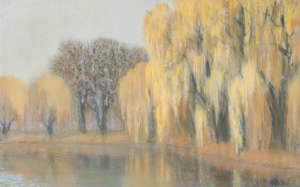Creativity Sivoplyasova
 To talk about the creative legend of Yevgeny Sivoplyasov turned out, you need to arm, above all, a sense of doubt. Perhaps the most important human feeling, without which any encounter with someone’s skill would end in an accident of self-confident misunderstanding due to the inability to see: what is hidden behind the display in the pupil? One on one with the pictures of Sivoplyasov, you realize this especially clearly. You will try with the air to appropriate his style, to determine, as if an unheard of exotic butterfly, – and then you realize that you have caught yourself; it is you who are in the net of your understanding, and your vision is like a faceted vision of an insect.
To talk about the creative legend of Yevgeny Sivoplyasov turned out, you need to arm, above all, a sense of doubt. Perhaps the most important human feeling, without which any encounter with someone’s skill would end in an accident of self-confident misunderstanding due to the inability to see: what is hidden behind the display in the pupil? One on one with the pictures of Sivoplyasov, you realize this especially clearly. You will try with the air to appropriate his style, to determine, as if an unheard of exotic butterfly, – and then you realize that you have caught yourself; it is you who are in the net of your understanding, and your vision is like a faceted vision of an insect.
Perhaps the main feature of his work is that the paintings themselves are embodiments of a unique form of being that happens outside you, completely independent, and, at the same time, in you. This is not a universal, but a significant part of the being, which is beyond the visible world, in the world, rather, felt and realized; to see it is the goal (perhaps unattainable, but so ticklish and desirable) of any person for whom the word “art” is a synonym for life, “modern art” is a synonym for one’s own life.
If contemporary art differs from the traditional answer to the question not “as expressed”, but “what is expressed”, the answers of Sivoplyasov are twofold in nature, oriented to both modernity and tradition. “As expressed,” that is, what seems to be recounted, was an invented by the artist’s authoring technique, the silence about the nature of which makes it necessary to see him as a cunning medieval master, who carefully guards the secret of the notion. “What is expressed” irreversibly refers to a collection of images that have the character of wandering plots: the face of the Savior, the images of saints, “The Flying Dutchman”, ideas about the vital activity of the cell or the image of the Universe, supplied either by microbiology data from Vernadsky’s “living matter” or by Tarkovsky’s “Solaris” with a mixed stunt plasma mix.
Taken together, the postulating spatiality and dynamism of the moments of being stopped by the artist’s hand, the cohesion “as expressed” with “what is expressed” allows us to assert the timelessness of his works. However, they can only be presented here, now, and never before. However, this is our weakness, because we know that any genuine work of art is timeless: it is “eternity strikes on a stone clock” (Mandelstam).
The legend of Sivoplyasov’s works is that, comparing them with what he saw, he still felt, he inevitably confronted with the unknown, which breaks slender, like DNA chains, reflections. If you look closely, you can grasp the similarity of his graphic manner, on the one hand, with the northern Renaissance and the Flemings: Altdorfer, Grünewald, Bosch, and partly with Lukas Cranach and Peter Breughel the Elder. On the other hand, with the works of Pavel Filonov, especially with his “White Picture” (1919), “Wolf” (1925), “Formula of Spring” (1927-1930), “Formula Revolution”, “Cosmos” (1920s ), “People” and “Faces” (1930s), or, remotely, in a pointiistic-cheap popular manner, with pictures of Boris Kustodiev. The Filonovian effects of optical illusion, which the author called “dual naturalism” (J.E. Boult), are inherent in Sivoplyasov’s works with their photoillusion to the same extent that the conventional Sivoplyasov’s figurativeness is more Teutonic-Prussian than a Mediterranean character: in his paintings Germanic Knights in the halls of baron castles may be seen more often than a Mediterranean vineyard in a girl with peaches.
Why not see at Sivoplyasova. It seems to be Altdorfer’s “Battle of Alexander with Darius” (1529) – not Altdorfer, it seems that Filonov’s “Formula of Spring” – and not Filonov, but also Bosch’s Last Judgment – but ridiculous. Bosch and Filonov – allegorical, eschatological, congested, detailed to the smallest – almost microscopic (when they believed in the ether and phlogiston), in Sivoplyasov – common sense of universal metamorphosis (when shimmy and foxtrot are forgotten), when round corners are straightened, the symbol is universal and universal, when versatile shimmy and foxtrot are rectified, when round corners are straightened, the symbol is universal and universal, when universalism is forgotten, when the shimmy and foxtrot are forgotten, when round corners are straightened, the symbolism is universal and universal, when universalism is forgotten, when corners and foxtrot are forgotten; joy, which is a pledge of hope.
Sivoplyasov creates at the same time scenery, chorus and character, as in the ancient tragedy. Only the viewer is not an Athenian potter, he does not look at the scene, washing down the garlic with diluted wine, but is imbued with a sense of discernment at the nature created by the artist (natura naturata) and the nature that creates (natura naturans) images of the past and modernity and the future, – as if doubting the fluidity of the time of creating works and scattering them on the whole space of visual art. Because the heart is big and the horizon is wide.
In his paintings one can see maps of worlds with text transferred on them, constantly changing, and not only by the will of the viewer, at least subconsciously, but also by himself, creating and creating from the inside, as, for example, in the works of Latvians from the text group Orbita. creating their own city from poems and random poems from words.




